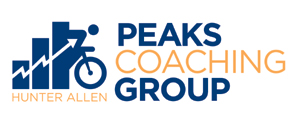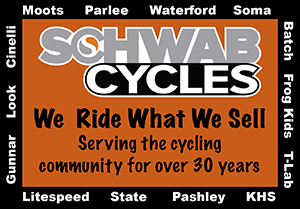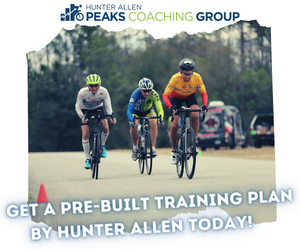

The Power of Bike Fit
By Hunter Allen, PCG Founder/CEO and Master Coach
Back to list of our training and coaching essays

Les Woodland's book Tour of Flanders: The Inside Story - The rocky roads of the Ronde van Vlaanderen is available as an audiobook here. For the print and Kindle eBook versions, just click on the Amazon link on the right.
Hunter Allen writes:
We all focus so much on the training part of our cycling—getting our intervals done, improving our FTP, creating a snappier sprint, developing our plan for the year—that sometimes I think many riders forget one of the most fundamental components of success on a bike. There are so many aspects of success that it’s hard to remember them all: training, nutrition, mindset, race tactics, good coaching, proper rest, etc. Each plays a role, some bigger than others, and many times the lack of one of these factors will be enough of a hole to prevent success at certain levels. For example, an athlete who has the physical ability but not the “killer instinct” to make the winning move will probably not be able to reach a high level. Possessing all these skills, factors, or components is important, along with the right balance of each. Some of these factors build upon themselves, much like the foundation of a house has to be strong and well-built for the rest of the house to last many years.
In cycling, one of the foundational factors is proper bike fit. If you don’t have your bike fit properly to you, there is no way you’ll be able to generate the maximum amount of power that you can. Bicycling is a highly constrained sport, in that your body’s movement is constrained to the movements necessary to ride, propel, and steer the bicycle. The dimensions of a bike frame are just like the dimensions of a packaging box. You have to fit all the stuff (your body) in the box (your bike) in order to ship it! Bicycling is a weird sport, let me tell you. Nowhere else in life are we hunched over with our arms extended out in front of us and our legs moving up and down in a circular pattern. It’s a downright foreign movement and position to be in!
Most bike racers get a bike and then have someone put an eye on their fit. In most of these cases the rider can get close to where he needs to be. There are some basic rules we all know about seat height and such that aren’t too complicated. However, everyone’s bones, joints, and muscles have different restrictions to their movement, different strengths and lengths, and different muscular firing patterns. All these differences make your bike fit even more important and ultimately have a lot to do with your ability to generate the maximum (or sub-maximum) power production. With that in mind, I encourage each and every one of you to go get a professional bike fit, if you haven’t already done so. This is the foundation of optimal power production, and no matter how hard you train or how gifted you are, you’ll never achieve your true potential if you don’t fit properly on your bike.
I have had the great opportunity to work many times with the man I consider to be the world expert in bike and pedaling mechanics: Tom Coleman in Boise, Idaho. He is the owner of www.wobblenaught.com. Tom and his Wobblenaught system is the best fit solution I have ever experienced, and Tom is the best pedaling coach I have ever met. Tom has come to two of my spring camps to fit all the campers and teach us many lessons on what produces the most powerful pedal stroke. You see, once you have the right bike fit, you’re in the position to produce the most power, but you still have to produce it!
Most people cannot even contract their muscles correctly to produce more power. I learned this a long time ago when I took some Pilates classes and the instructor was tried to teach me some basic moves. I literally did not know how to make the brain-to-muscle connection necessary to do the moves. Sometimes we just don’t contract or use muscles other people use when doing the exact same exercise because we don’t have that mind-body connection. Tom says, "If you can change the brain of the user, you can change the muscle."
Another example of this was a client of mine who was a very good Category 1 racer. When you looked at his legs, they just didn’t look like the legs of a Cat 1. He was missing something. Finally I realized that he had never developed one of the most important and powerful cycling muscles, the VMO, or Vastus Medialis Obliquus, which is that big knot of a muscle just above and to the side of your kneecap. This rider, for one reason or another, had been able to recruit other muscles to pedal but was missing a very important and strong one. I was never able to get him to work on that, but I suspect he would have become a good domestic pro had he been open to improving it.
How do you figure out if you’re using the right muscles at the right time in your pedal stroke? Doesn’t everyone fire them all the same way at the same time? After all, we all clip in and pedal in circles in that highly constrained environment of a bicycle. The answer is no, we do not all pedal the same way, nor do we use the same muscles to pedal. You see, the cerebral cortex, or the motor area of the cerebral cortex, sends the signal down through the brain stem in the spinal cord, and the driving forces behind this signal are your emotions, your movement, and your posture. Not everyone functions the same, since we all have different postures, different emotions, and different movement patterns.
At first I found this hard to believe because I’d always figured everyone pedaled the same way, but when I got a chance to benefit from Tom’s coaching myself I started to understand. Tom is the only guy in the world (that I know of) who can wire up all your leg muscles using sEMG (electromyography). Electromyography is the study of muscle function through the inquiry of the electrical signal the muscles emanates. It is driven by the neuromuscular system. The energy generated by the muscle has a very small value and is measured in millionths of a volt (micro-volts). It is necessary to use very sophisticated and sensitive instruments to amplify this signal so it can be seen and heard. In essence, a surface electro-myography (sEMG) is nothing more than a very sensitive volt meter. Tom says, "A good analogy is using bird songs or thunderstorms in the distance. It takes a while for the noise to get to the meter, and that’s what we are reading, and it’s called bio-feedback. So the athlete is watching the noise of the muscle and then changing his pedaling mechanics to correct his stroke. We don’t get caught up in how much the muscle fires; it’s more important to see if the muscle is 'on' or 'off.'"

When riders use the sEMG, they ride a trainer, and their muscle firing patterns are projected onto a wall in front of them so they can react to the bio-feedback and to Tom’s verbal coaching. (Tom also has a telemetry unit in which a cyclist rides on the road while Tom observes the electrical discharge and coaches the athlete via an earpiece.) Tom puts riders through their paces, having you pedal heel down, heel up, knees out, knees in, and in all sorts of other positions. All the while, the riders can instantly observe how each position impacts the readings in the muscles. After about ten minutes of this coaching, Tom has the athlete start to work on the muscles that are needed for pedaling but that are either not contracting or not contracting at the level needed for optimal power.
Does it work? Darn right it does! Do you improve? Do you put out more power than before and for the same cost? Yes! It’s amazing. More than a dozen athletes of mine have flown out to spend the day with Tom and get this amazing coaching and bike fit, and each one of them has been able to produce more power afterward. In particular, a client of mine from England, Simon Breakwell, flew out to spend the day with Tom and me and get proper bike fit and sEMG pedal coaching. Simon was an excellent masters rider and wanted to go to the next level, so we pulled out all the stops to make him the best he could be.
The year before, Simon’s best twenty-minute wattage averaged 334 watts for the year, with a peak of 372 watts in early May. After a good six weeks of training at tempo/endurance pace with some occasional harder efforts thrown in for good measure, along with a dramatic change in his pedaling style, Simon cracked out 351 watts at his next test, an average of 5% improvement from his yearly average and a whopping 15% improvement since his previous test. Is 5% significant? Absolutely! I’ll take 351 watts over 334 watts any day. That could be the difference between winning a race and getting dropped.

During those six weeks of training, Simon spent a significant amount of his riding time really focusing on what he’d learned about his pedal stroke from Tom’s sEMG analysis. Not only was his twenty-minute mean maximal power up, he also improved his best one-minute power by 14% and his best five-minute power by 10%. Talk about across-the-board improvement!
Clearly the bike fit and sEMG pedal coaching, along with smart training (I’d like to think my coaching helped) made a difference. Simon was now in the proper position on his bike to produce the maximal power across all time durations. He also understood exactly how to produce more power with his pedal stroke. This is critical in order for him to maximize his potential and build self-confidence. To absolutely know without a doubt that you are in the perfect position on the bike and that you are pedaling the most effectively is really an advantage. Furthermore, for an athlete to see a 5% improvement in six weeks is pretty incredible. Many athletes can go for an entire season without this kind of improvement in their twenty-minute mean maximal power.

This is just one example I have seen from getting a proper bike fit and learning a better mind-body connection for more effective and efficient pedaling. While the best position on the bike and the best pedal stroke won’t win races, I know they are key factors for success. When you put key factors together, especially foundational key factors, you have a recipe for success. Mindset, hard training, good genetics, killer instinct, the ability to suffer, an understanding of power training principles, bike fit, and even how you pedal all play roles in your success. Without a proper balance of each, it’s tough to be successful in this highly competitive world of cycling.
Hunter Allen is a USA Cycling Level 1 coach and former professional cyclist. He is the co-author of Training and Racing with a Power Meter, co-developer of TrainingPeaks’ WKO software, and CEO and founder of Peaks Coaching Group. He and his coaches create custom training plans for all levels of athletes. Hunter can be contacted directly through www.PeaksCoachingGroup.com.
.









